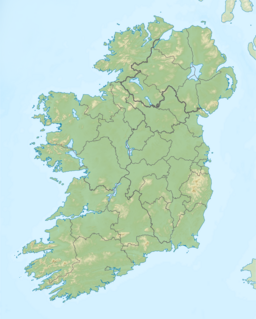Glencar Lough
| Glencar Lough | |
|---|---|
| Loch Ghleann an Chairthe (Irish) | |
 West towards Benbulbin | |
| Location | County Leitrim, County Sligo |
| Coordinates | 54°20′22″N 8°23′9″W / 54.33944°N 8.38583°W |
| Lake type | Glacial lake |
| Primary inflows | Glencar Waterfall, Diffreen River |
| Primary outflows | Drumcliff River |
| Catchment area | 41.22 km2 (15.92 sq mi) |
| Basin countries | Ireland |
| Max. length | 2.5 km (1.6 mi) |
| Max. width | 0.6 km (0.37 mi) |
| Surface area | 1.15 km2 (0.44 sq mi) |
| Surface elevation | 28 m (92 ft) |
| References | [1][2][3] |
Glencar Lough (Irish: Loch Ghleann an Chairthe, meaning 'lake of the glen of the pillar stone'),[4][5] locally known as Glencar Lake, is a freshwater lake in the northwest of Ireland. It covers an area of 1.15 square kilometres (284 acres) and lies mostly in County Leitrim with a smaller part in County Sligo. Glencar Waterfall is located near the lake's north shore on the Leitrim side.
Geography
[edit]
Glencar Lough lies in the Glencar Valley, between the Dartry Mountains to the north and the mountain range including Cope's Mountain to the south. The lake is located about 10 kilometres (6 mi) northeast of Sligo and about fifteen kilometres (9 mi) west of Manorhamilton. It is 2.5 km (1.6 mi) long from west to east and 0.6 km (0.4 mi) wide.[2] The lake has two crannogs (artificial islands): one at the western end near the Drumcliff River outlet and the other at the eastern end near the Diffreen River.[3]

Hydrology
[edit]
Glencar Lough is primarily fed by Glencar Waterfall, on the lake's northern shore, and by the Diffreen River, entering at the lake's eastern end. Sruth in Aghaidh an Aird also flows out to the northern shore, just west of the Glencar Waterfall outflow. The lake drains west into the Drumcliff River, which in turn flows into Sligo Bay.[3] Lake depth is greatest near the southern shore with a shallower shelf at the northern shore.[6]
Natural history
[edit]
Fish present in Glencar Lough include salmon and brown trout.[6] Bird life includes tufted duck, pochard and goldeneye. These are migratory species which winter at the lake.[2]
Ecology
[edit]The water quality was reported to be excellent c. 2001 – c. 2003 with an oligotrophic rating.[7][n 1] The ecology of Glencar Lough, and other Irish waterways, remain threatened by curly waterweed, zebra mussel, and freshwater clam invasive species.[9][10]
History
[edit]Historically Glencar Valley was known as Glenn-Dallain[11] and was part of the Kingdom of Breifne. The lake and its crannogs, then occupied, are mentioned in the Annals of the Four Masters, specifically the eastern crannog where "the sons of Donough O'Rourke, i.e. Donnell and Ferganainm, made an attack upon the crannog, and privately set fire to the town".[12]
Economy
[edit]Barite was mined at Glencarbury in the Dartry Mountains above the lake between 1894 and 1979. A cable ropeway from the mine area to the lake shore was constructed in 1942. By this means the extracted barite was taken down for onward road transport.[13]
The Glencar Water Company has its bottling plant located near the lake's northern shore. The company, established in 2008, sells water drawn from an onsite spring emanating from within the nearby Dartry Mountains.[14]
See also
[edit]References and notes
[edit]Notes
[edit]- ^ Trophic states of "Oligotrophic" and "Mesotrophic" are desirable, but freshwater lakes rated 'Eutrophic' or 'Hypertrophic' indicates pollution.[8]
Primary sources
[edit]- ^ Free, Gary; Little, Ruth; Tierney, Deirdre; Donnelly, Karol & Caroni, Rossana (2006). A Reference Based Typology and Ecological Assessment System for Irish Lakes (PDF) (Report). Environmental Protection Agency (Ireland). p. 12. Retrieved 12 October 2022.
- ^ a b c "Glencar Valley". BirdWatch Ireland. Archived from the original on 4 March 2016. Retrieved 28 March 2015.
- ^ a b c "OSI Mapviewer". Ordnance Survey Ireland. Archived from the original on 29 August 2012. Retrieved 28 March 2015.
- ^ "Loch Ghleann an Chairthe/Glencar Lough". Placenames Database of Ireland. Government of Ireland - Department of Arts, Heritage and the Gaeltacht and Dublin City University. Retrieved 7 August 2015.
- ^ Joyce, Patrick Weston (1984) [1871]. Pocket guide to Irish place names. Belfast: Appletree Press.
- ^ a b "Fishing in Ireland - Glencar Lake and Drumcliff River". Inland Fisheries Ireland. Retrieved 28 March 2015.
- ^ Clenaghan, Clinton & Crowe 2005, pp. 97.
- ^ Clenaghan, Clinton & Crowe 2005, pp. 8.
- ^ Pedreschi et al. 2014.
- ^ Clenaghan, Clinton & Crowe 2005, pp. 16.
- ^ Saint Caillin (1875) [c. 560]. Hennessy, W. M. (ed.). The Book of Fenagh. Translated by D. H. Kelly. Dublin: Alexander Thom. p. 403.
- ^ O'Donovan, John, ed. (1856). Annála Rioghachta Éireann. Annals of the Kingdom of Ireland by the Four Masters ... with a Translation and Copious Notes. 7 vols. Translated by O'Donovan (2nd ed.). Dublin: Royal Irish Academy. s.a. 1541.8 CELT editions. Full scans at Internet Archive: Vol. 1; Vol. 2; Vol. 3; Vol. 4; Vol. 5; Vol. 6; Indices.
- ^ Williams, Mary Anne (2008). Landscapes, Rocks and Fossils: The Geological Heritage of County Sligo. Sligo Regional Technical College. pp. 6, 22. ISBN 978-0-9555-6531-1.
- ^ Gray, Jim (30 April 2008). "Glencar water springs up". The Sligo Champion. Retrieved 30 March 2015 – via Irish Independent.
Secondary sources
[edit]- Clenaghan, Conor; Clinton, Frank; Crowe, Matthew (2005). Phosphorus Regulations National Implementation Report (PDF) (Report). Environmental Protection Agency, Office of Environmental Enforcement.
- Pedreschi, D.; Kelly-Quinn, M.; Caffrey, J; O'Grady, M.; Mariani, S.; Phillimore, A. (2014), "Genetic structure of pike (Esox lucius) reveals a complex and previously unrecognized colonization history of Ireland", Journal of Biogeography, 41 (3), Journal of Biogeography, 41(3), 548–560.: 548–560, doi:10.1111/jbi.12220, PMC 4238397, PMID 25435649

